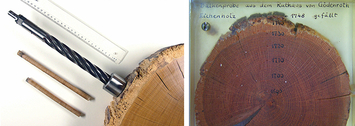LABORATORY

PALEOBOTANY
Paleobotany is the analysis of the macro-remains of plants. Its aim is to identify preserved remnants of plants in archeological layers or in the material dumped in old excavated pits. By analyzing this material, it is possible to discover which species grew in the area at a particular time in history, or to reveal which plants people cultivated, used or excreted (in the case of cesspits). This gives us information about what people ate, the range of crops they grew, the farming techniques they used, the materials they used as bedding for animals, and much more.
DENDROCHRONOLOGY
Dendrochronology is a scientific method of dating, based on analyzing the growth rings of trees. Using this technique, we can determine the precise year and season (winter/summer) when a particular tree was cut down. For precise dating, the part of the tree next to the bark needs to have been preserved, and there need to be enough growth rings. At the Lauby site, dendrochronological analysis was mainly used to date the timber structures of three cesspits.
ARCHEOZOOLOGY
Archeozoology is a scientific discipline that studies the bone remains of animals found at archeological sites. This gives us information about which types of meat people ate, as well as which types of animals (species and breeds) were domesticated. Archeozoology can also provide insights into the decline of wild species, the composition of herds, the nutritional state of animals, butchering practices, the preparation and processing of animal products, and the use of kitchen waste.
PALEOPARASITIC ANALYSIS
Paleoparasitic analysis is a scientific discipline that identifies the presence of parasitic diseases in a particular historical period. It does so mainly by analyzing material from locations where human faeces was deposited – such as the cesspits at Lauby. This enables us to find out how widespread parasitic infestation was in a particular community and to gain insights into hygiene practices.
Akce: Otevřít verzi pro tisk
